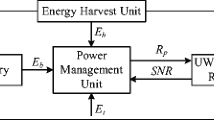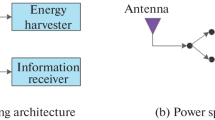Abstract
Impulse Radio Ultra-wideband (IR-UWB) technique has long been recognized for its unique carrierless operation as compared with other communication techniques. The simple and low-cost structure offers great advantages for self-powered embedded wireless systems, in which energy efficiency is a challenging issue due to the fact that most renewable energy sources only offer limited and unstable power supply. In this paper, we present an energy-adaptive Pulse Amplitude Modulation technique for self-powered IR-UWB based communication systems to improve data rate and or time coverage. The basic idea is derived from the fact that domain-specific information in such applications are often available; thus, by jointly exploiting the wireless channel conditions and the non-deterministic characteristics of renewable energy sources, the proposed technique dynamically adjusts the modulation level to enhance the sustainable operation under the unreliable energy supply. Simulation results demonstrate that the proposed technique achieves a much higher data rate and better time coverage than conventional UWB systems. The proposed technique is also insensitive to many practical issues such as the battery aging effect.








Similar content being viewed by others
References
Siwiak, K., & McKeown, D. (2005). Ultra-wideband radio technology. Chichester: Wiley.
Zhuang, W., Shen, X. S., Bi, Q. (2003). Wireless Communications and Mobile Computing. Wireless Communications and Mobile Computing, 3(6), 663–685.
Yaddanapudi, P., Vallepali, N., Popescu, D. C., Shadaram, M. (2007). Performance analysis of multiband TH-PAM and multiband-OFDM UWB communications systems. In Radio and wireless symposium, 2007 IEEE (pp. 503–506).
IEEE Standard for Information Technology, Telecommunications and Information Exchange Between Systems, Local and Metropolitan Area Networks, & Specific Requirement Part 15.4. (2007). Wireless medium access control (MAC) and physical layer (PHY) specifications for low-rate wireless personal area networks (WPANs). IEEE Std 802.15.4a-2007 (Amendment to IEEE Std 802.15.4-2006) IS–SN–VO–, (pp. 1–203).
Khaleghi, A., Chavez Santiago, R., Balasingham, I. (2010). Ultra-wideband pulse-based data communications for medical implants. Communications, IET, 4(15), 1889–1897.
Xia, L., Lo, A., Niemegeers, I., Bauge, T. (2008). An ultra-wide band based ad hoc networking scheme for personnel tracking in emergencies. In Pervasive computing technologies for healthcare, 2008. PervasiveHealth 2008. Second international conference on IS–SN–VO– (pp. 78–81).
Kim, E. C., Park, S., Cha, J. S., Kim, J. Y. (2010). Improved performance of UWB system for wireless body area networks. IEEE Transactions on Consumer Electronics, 56(3), 1373–1379.
Simic, D., Jordan, A., Tao, R., Gungl, N., Simic, J., Lang, M., Van Ngo, L., Brankovic, V. (2007). Impulse UWB radio system architecture for body area networks. In Mobile and wireless communications summit, 2007. 16th IST IS–SN–VO– (pp. 1–5).
Zito, D., Pepe, D., Mincica, M., Zito, F. (2011). A 90nm CMOS SoC UWB pulse radar for respiratory rate monitoring. In Solid-state circuits conference digest of technical papers (ISSCC), 2012 IEEE International (pp. 40–41).
Wu, D., Li, R., Li, R., Liang, H., Luo, J. (2008). Localization in UWB sensor networks for agriculture environment. In Wireless communications, networking and mobile computing, 2008. WiCOM ’08. 4th International Conference on IS–SN–VO– (pp. 1–4).
Jiang, X., Polastre, J., Culler, D. (2005). Perpetual environmentally powered sensor networks. In Information processing in sensor networks, 2005. IPSN 2005. Fourth International Symposium on IS–SN–VO– (pp. 463–468).
Mateu, L., & Moll, F. (2005). Review of energy harvesting techniques and applications for microelectronics (Keynote Address), (pp. 359–373 VL–IS–).
Koltsidas, G., Karapistoli, E., Pavlidou, F. N. (2008). An energy-aware self-organizing clustering algorithm for UWB wireless sensor networks. In Personal, indoor and mobile radio communications, 2008. PIMRC 2008. IEEE 19th International Symposium on IS–SN–VO– (pp. 1–5).
Chen, J., Cui, J. H., Wang, L. (2012). Energy-adaptive modulation for RF power management under renewable energy. In 2012 IEEE workshop on signal processing systems (SiPS) (IEEE) (pp. 173–178). IEEE.
Chavez-Santiago, R., Khaleghi, A., Balasingham, I., Ramstad, T. A. (2009). Architecture of an ultra wideband wireless body area network for medical applications. In Applied sciences in biomedical and communication technologies, 2009. ISABEL 2009. 2nd International Symposium on IS–SN–VO– (pp. 1–6).
Di Benedetto, M. G., & Giancola, G. (2004). Understanding ultra wide band radio fundamentals. Prentice Hall communications engineering and emerging technologies series. Upper Saddle River: Prentice Hall PTR.
Popescu, D. C., Yaddanapudi, P., Vallepalli, N., Raju, G. VS. (2008). A simulation comparison of time-hopping PAM and interference suppressing OFDM in multiuser ultra wideband communications systems. In Radio and wireless symposium, 2008 IEEE IS–SN–VO– (pp. 875–878).
Abraha, S. T., Okonkwo, C., Gamage, P. A., Tangdiongga, E., Koonen, T. (2012). Routing of power efficient IR-UWB wireless and wired services for in-building network applications. Journal of Lightwave Technology, 30(11), 1651–1663.
Cui, S., Goldsmith, A. J., Bahai, A. (2005). Energy-constrained modulation optimization. IEEE Transactions on Wireless Communications, 4(5), 2349–2360.
Lee, T. H. (2004). The design of CMOS radio-frequency integrated circuits. Cambridge: Cambridge University Press.
Proakis, J., & Salehi, M. (2007). Digital communications. New York: McGraw-Hill higher education. McGraw-Hill Education.
Durisi, G., Romme, J., Benedetto, S. (2003). A general method for SER computation of M-PAM and M-PPM UWB systems for indoor multiuser communications. In Global telecommunications conference, 2003. GLOBECOM ’03. IEEE IS–SN– (vol.2, pp. 734–738).
Lu, J., Liu, S., Wu, Q., Qiu, Q. (2010). Accurate modeling and prediction of energy availability in energy harvesting real-time embedded systems. In Green computing conference, 2010 International IS–SN–VO– (pp. 469–476).
Chen, Y., & Beaulieu, N. C. (2009). Superior NDA ML delay and gain estimators for UWB channels. In IEEE International Conference on communications, 2009. ICC ’09 (pp. 1–4).
Ingram, S. J., Harmer, D., Quinlan, M. (2004). UltraWideBand indoor positioning systems and their use in emergencies. In Position location and navigation symposium, 2004. PLANS 2004 IS–SN–VO– (pp. 706–715).
Lin, S., & Costello, D. J. (2004). Error control coding, vol. 123. Englewood Cliffs: Prentice-hall.
Hernandez, M., & Kohno, R. (2011). UWB systems for body area networks in IEEE 802.15.6. In 2011 IEEE International Conference on ultra-Wideband (ICUWB) (pp. 235–239).
Moser, C., Brunelli, D., Thiele, L., Benini, L. (2007). Real-time scheduling for energy harvesting sensor nodes. Real-Time Systems, 37(3), 233–260.
Moorfeld, R., Lu, Y., Finger, A. (2012). Energy detection with optimal symbol constellation for M-PAM in UWB fading channels. In 2011 IEEE International Conference on ultra-Wideband (ICUWB) (pp. 397–401).
Takizawa, K., Aoyagi, T., Kohno, R. (2009). Channel modeling and performance evaluation on UWB-based wireless body area networks. In IEEE International Conference on communications, 2009. ICC ’09 (pp. 1–5).
Chen, X., Lu, X., Jin, D., Su, L., Zeng, L. (2011). Channel modeling of UWB-based wireless body area networks. In 2011 IEEE international conference on communications (ICC) (pp. 1–5).
Kadirvel, K., Ramadass, Y., Lyles, U., Carpenter, J., Ivanov, V., McNeil, V., Chandrakasan, A., Lum-Shue-Chan, B. (2012). A 330nA energy-harvesting charger with battery management for solar and thermoelectric energy harvesting. In Proc. IEEE solid-state circuits conference digest of technical papers (ISSCC’12) (pp. 106–108).
Author information
Authors and Affiliations
Corresponding author
Appendix A
Appendix A
1.1 Proof of Eq. 21
In this appendix, we prove the energy thresholds for the energy-adaptive PAM as expressed in Eq. 21.
As discussed in Section 2.2, the power consumption of the IR-UWB circuit employing a PAM scheme can be expressed as a function of the number of bits per symbol N b = log2M as
where P t (N b ) is an increasing function of N b . As a result, under the same amount of available energy, the circuit on time T o n during a time slot with the period T s decreases with N b , i.e.,
Note that T o n (N b ) can also be recast as a piecewise function of the available energy E b + E h as
Substituting T o n (N b ) from Eq. 29 into Eq. 14, the average data rate over the time period T s can also be expressed as a piecewise function as
From Eq. 30, when the available energy is insufficient for the IR-UWB circuit to work over the entire time period T s , i.e. \(E_{b}+E_{h} \le P_{t}(N_{b})T_{s}\), \(r_{N_{b}}\) is a linearly increasing function of the available energy, as shown in Fig. 9 for 2-, 4-, and 8-PAM under normalized energy values. Note that the 2-PAM has the largest slop whereas the 8-PAM has the smallest slop in their corresponding linear ranges. This reflects the practical scenario where, when the available energy is smaller than a certain threshold, e.g, less than T s P t (1), 2-PAM will be selected as it achieves a higher data rate. This is consistent with the observation that, when the available energy is small, a low level modulation scheme should be selected.
Figure 9 clearly shows that the energy threshold between two modulation levels N b and N b + 1 is the crosspoint between the constant range of the modulation level N b and the linear range of the modulation level N b + 1. For example, consider the crosspoint corresponding to E 2, 3. When the available energy is less than E 2, 3, 4-PAM has a larger data rate; whereas when available energy is larger than E 2, 3, the data rate of 8-PAM becomes larger. At this crosspoint, the data rates of the two modulation schemes are equal, which can be expressed as,
Substituting P t (N b + 1) from Eq. 27 into Eq. 31, the energy threshold is obtained as
which proves the energy thresholds for the energy-adaptive PAM as expressed in Eq. 21.
Another interesting observation is that in Fig. 9, the shadowed areas reflect the degradation in data rate if a full-time coverage is required, as discussed in Eq. 3.2. For example, when the available energy is larger than E 2, 3, 8-PAM would be selected but this scheme cannot achieve full-time coverage, i.e., T o n (3) < T s . To achieve a full-time coverage, 4-PAM should be select, resulting the data rate degradation as visualized by the shadowed area between E 2, 3 and T s P t (3).
Rights and permissions
About this article
Cite this article
Zhao, D., Chen, J. & Wang, L. Energy-adaptive Pulse Amplitude Modulation for IR-UWB Communications Under Renewable Energy. J Sign Process Syst 76, 121–132 (2014). https://doi.org/10.1007/s11265-013-0855-y
Received:
Accepted:
Published:
Issue Date:
DOI: https://doi.org/10.1007/s11265-013-0855-y





